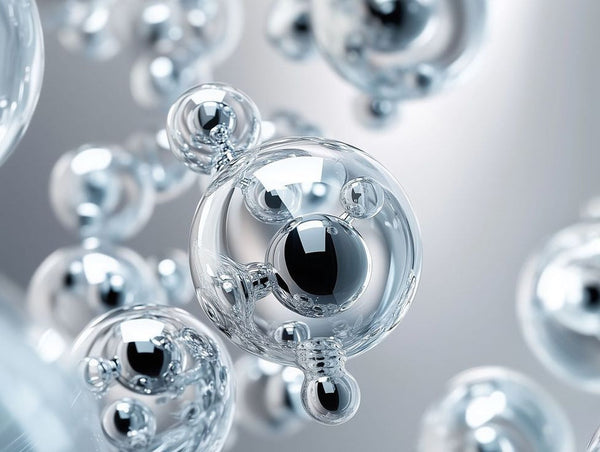Whether you’re trying to improve your diet or build muscle, we’ve all heard about the need for enough protein. But when we say protein, we mean amino acids. Let’s understand everything about them and all that our body needs, they’re also called the building blocks of life so read on to know why.
Amino Acids: A Humble Introduction
What are Amino acids? they’re small chains that combine to form large proteins essential for various body functions. Think of proteins as a complex structure made of amino acid "bricks." There are 20 unique amino acids, each with a specific role. Each amino acid has a central carbon atom bonded to an amino group (NH2), a carboxyl group (COOH), and a unique side chain. These amino acids link to form peptides, which then join to create proteins.
Importance of Amino Acids
Now that we know the basics and the amino acid structure, let's explore why they play a vital part in helping us function.
-Protein Synthesis: Helping your body build and repair proteins.
-Immune Function: Supporting your body's defense system to fight off illnesses
-Enzyme Production: Making the substances that speed up important chemical reactions in your body.
-Better Neuro-System Communication: Creating the chemicals that help your brain and nerves communicate.
-Energy Production: Boosting your body's ability to produce energy
-Nutrient Transport and Storage: Assisting in moving and storing essential nutrients throughout your body.
-Tissue Repair: Aiding in healing cuts and repairing tissues.
-Hormone Production: Helping your body build hormones that regulate various functions.
Types of Amino Acids
There are three types of amino acids you should be familiar with; essential, non-essential, and semi-essential. Understanding these categories will help you appreciate how your body utilizes these vital compounds.
Essential Amino Acids
Essential amino acids cannot be synthesized by the body and must be obtained through diet. There are nine essential amino acids:
Histidine: Important for growth, the production of blood cells, and tissue repair.
Isoleucine: Helps with muscle metabolism and is heavily concentrated in muscle tissue.
Leucine: Stimulates muscle growth and helps with the regulation of blood sugar levels.
Lysine: Essential for protein synthesis, hormone and enzyme production, and the absorption of calcium.
Methionine: Plays a critical role in metabolism and detoxification.
Phenylalanine: Precursor for the neurotransmitters tyrosine, dopamine, epinephrine, and norepinephrine.
Threonine: Vital for collagen and elastin production.
Tryptophan: Precursor for serotonin, which regulates mood, sleep, and appetite.
Valine: Stimulates muscle growth and regeneration.
Non-Essential Amino Acids
Non-essential amino acids can be synthesized by the body and are not required to be obtained from the diet. There are eleven non-essential amino acids:
- Alanine: Involved in glucose metabolism
- Arginine: Important for immunity and hormone secretion
- Asparagine: Critical for the production of other proteins
- Aspartic Acid: Involved in hormone production and release
- Cysteine: Contributes to metabolism and detoxification
- Glutamic Acid: Key for cognitive functions such as learning and memory
- Glutamine: Supports immune function and intestinal health
- Glycine: Involved in the production of other amino acids
- Proline: Vital for collagen production
- Serine: Important for metabolism
- Tyrosine: Precursor to neurotransmitters and hormones
Semi-essential Amino Acids
Semi-essential amino acids, also known as conditionally essential amino acids, are typically produced by the body and don't need to be obtained from your diet. But remember, during times of illness, stress, or stages of rapid growth such as childhood, adolescence, and pregnancy, the body can't produce enough of them. In these situations, they must be obtained through dietary sources. The semi-essential amino acids include arginine, cysteine, glutamine, tyrosine, ornithine, proline, and serine.
How Amino Acids Work Together
Amino acids link together in various sequences to form chains of amino acids, known as peptides. These peptides then fold into specific shapes to become functional proteins.
Imagine a word game where each amino acid is a letter. The way you arrange the letters (amino acids) forms different words (proteins), each with its unique meaning and function. This chain of amino acids is crucial in determining the protein's role in the body.
Getting Amino Acids from Your Diet
To ensure your body has all the amino acids it needs, it's important to eat a balanced diet that includes a variety of protein sources. Here are some excellent dietary sources:
- Meat and Poultry: Rich in all essential amino acids.
- Seafood: Another complete protein source.
- Dairy Products: Milk, cheese, and yogurt are good sources.
- Legumes and Beans: Peas, Kidney Beans, Lentils, Chickpeas, and Soybeans are great plant-based sources of amino acids.
- Nuts and Seeds: Almonds, Walnuts, Chia Seeds, and Pumpkin Seeds are some rich and Provide essential amino acids.
- Whole Grains: Quinoa, Millet, Buckwheat are some grains that contribute to your amino acid intake.
- Dietary supplements like multivitamins and plant-protein powders are also a good source of all amino acids in a combined, bioavailable form.
Pro Tip: Combining two plant sources can create a complete protein.
Conclusion
Understanding amino acids, their importance and the different types is crucial for maintaining health, as these building blocks of life play key roles in physiological processes. Ensure a sufficient supply through diet or supplements, focusing on protein-rich foods to obtain all essential amino acids. This knowledge empowers you to make informed dietary choices for overall well-being. Share your thoughts or questions in the comments to continue the discussion on these essential compounds!
People also ask:
Amino acids interact with various nutrients in the body to support essential physiological functions. They collaborate with vitamins and minerals to synthesize proteins, produce neurotransmitters, and enhance immune function. For instance, vitamin B6 aids amino acid metabolism, while vitamin C is crucial for collagen formation involving amino acids like glycine and proline. Additionally, amino acids like cysteine help produce antioxidants, requiring other nutrients like selenium.
Amino acids are important for protein synthesis, to convert nutrients into usable energy. They are also essential for repairing tissues, supporting immune function, and producing hormones and enzymes. Amino acids are also essential for synthesizing neurotransmitters, crucial for brain function and mood regulation.
Absolutely. Amino acid supplements provide all the essential amino acids in a single dose with maximum RDA and high bioavailability. This is an ideal source since the food at times is unable to provide us with all necessary proteins and amino acids.
Amino acids or their supplements are usually safe to consume, however, it's important to be mindful of your intake. Taking amino acids in the right amounts can greatly benefit your health. By consulting with a healthcare professional and following recommended guidelines you can enjoy the positive effects of amino acids while ensuring safe and effective use. The recommended daily allowance for every 2.2 pounds of body weight for each of the essential amino acids is Histidine: 14 milligrams. Isoleucine: 19 milligrams. Leucine: 42 milligrams.




























